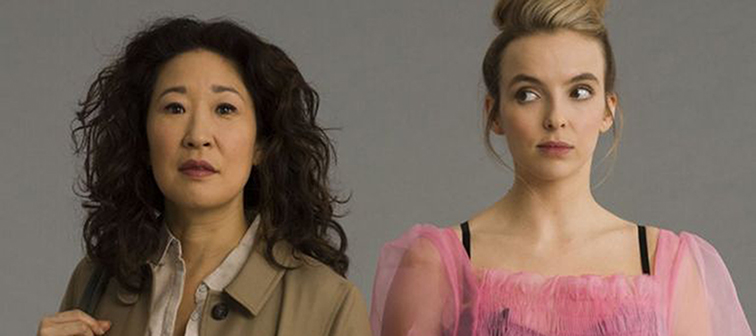
Photograph: Sid Gentle Films
As series three of the multi-award-winning TV series Killing Eve returns to our screens today, here's another chance to read a blog by Professor Alec Charles exploring the anatomy of a screen psychopath.
There's something appallingly attractive about film and television's most celebrated homicidal psychopaths. (However, one imagines that, for most people at least, the qualities of real-life serial killers seem somewhat less seductive.)
As the BBC's Killing Eve returns to our screens - and threatens once more to dominate our thoughts and conversations for the next eight weeks - it's perhaps worth taking a moment to look back upon some of Villanelle's more illustrious precursors in the history of great screen psychopathy.
Although he wasn't cinema's first such figure, Alfred Hitchcock's Norman Bates - from 1960's Psycho - remains its most influential and iconic. The genius of Hitchcock's acclaimed film is that it promotes its audience's empathy with the psychopath. The psychopathic killer is still a monster - a tormented and tormenting figure - but he is not a monstrous other. He is a monstrous self.
Hitchcock allows us to see the world (at times literally) through Norman Bates's eyes. Bates is initially established as a mildly creepy but mild-mannered and sympathetic figure, an introverted taxidermist who appears shy with girls and is dominated by a sadistic (but unseen) mother. Norman is the victim, a victim who has the gory task of clearing up his mother's mess - cleaning up after his mother has brutally murdered a guest taking a shower at the Bates Motel. We feel for Norman - we share the suspense as he disposes of his mother's latest victim's corpse, willing him not to get caught. It's only towards the end of the film that we discover what's now cinema's worst-kept secret - that Norman Bates and his mother are one and the same person. By that time, Hitchcock has us hooked: we have come to empathize with Norman Bates.
Bates beguiles us with his apparent and actual innocence - whether played on film by Anthony Perkins or on television by Freddie Highmore. We are similarly seduced by the almost childlike directness and (superficial) lack of complexity exhibited by Killing Eve's Villanelle. We find ourselves drowning in their depthlessness.
By stark contrast, Hollywood's second most engaging serial killer Hannibal Lecter, in his several incarnations (most famously as portrayed by Anthony Hopkins and Mads Mikkelsen), stands at the opposite end of the spectrum of social sophistication. Lecter is more obviously charming than Bates, a bon vivant and an international man of mystery. To some extent then Lecter is also reflected in Jodie Comer's worldly and stylish Villanelle. Villanelle embodies the paradox of a sophisticated ingénue; and for that reason fascinates us all the more.
Villanelle has something else in common with Hannibal Lecter. Both become obsessed with their nemeses - MI5's Eve Polastri and the FBI's Will Graham and Clarice Starling respectively. Both appear almost to fall in love with the women and men who have hunted them - insofar as they are capable of feeling anything at all resembling love.
Theirs is a strange and dark kind of love, one which is (perhaps most strangely) not entirely unrequited. It is a brutally self-sacrificing love, a cruel version of love which sees Lecter sever his own hand rather than Starling's, Hannibal and Will falling together from a cliff-edge in a final, fatal embrace (in an unusually erotic version of the struggle between Holmes and Moriarty at the Reichenbach Falls), and the stabbing of Villanelle by Eve at the moment of their romantic epiphany at the end of their first series together.
All this was again anticipated in Hitchcock's Norman Bates. When Bates first meets Marion Crane - soon to be the victim in Psycho's notorious shower scene - they enjoy a quiet conversation which seems almost tender in its sympathetic intimacy. Eve, Will and Clarice simply manage to make those perilous relationships last rather longer. In doing so, they allow us vicariously to experience what it might be like to feel the heat of, and to reciprocate, the psychopath's distorted, raw and deadly love. When we step with our protagonists into the killers' shoes or fall into their beds or their embrace, for one satisfying, terrifying moment we recognise the simultaneous temptations and dangers of their bloody lives' bitterly cloying tastes.
The screen psychopath is a fantastical creation of the unconscious mind: it is where the libido meets the death-drive. They have very little to do with the psychopaths (or even the psychopathic murderers) of the real world. The real world's serial killers are rarely known to be motivated by Dexter's moral concerns or Hannibal's aesthetic preferences in orchestral music and haute cuisine. Their lives are rarely as glamorous as those of such ruthless assassins and femmes fatales as Uma Thurman's The Bride or Jodie Comer's Villanelle. They are rarely even as sweet as Norman Bates.
Yet they offer an imaginary representation of our impossible craving to experience - or at least to come close to experiencing - the awful freedom not of real psychopathy but of desires felt and fulfilled without remorse or restraint. And they remind us relentlessly of that terrible freedom's terrible price.
Thumbnail photograph on Press Centre page: BBC
Press Office | +44 (0) 1962 827678 | press@winchester.ac.uk | www.twitter.com/_UoWNews
Back to media centre